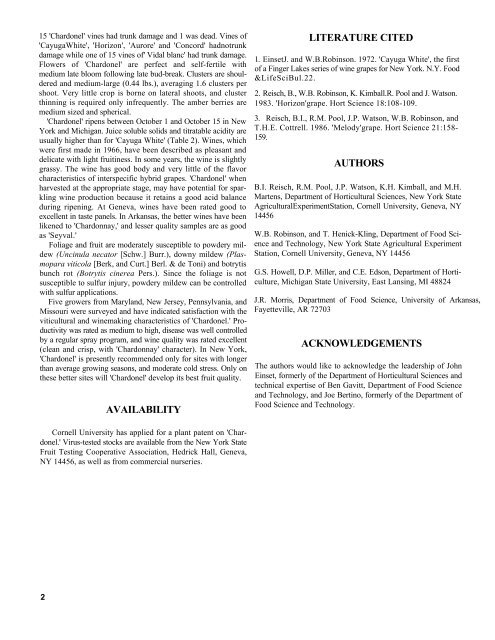'CHARDONEL' Grape - Horticulture - Cornell University
'CHARDONEL' Grape - Horticulture - Cornell University
'CHARDONEL' Grape - Horticulture - Cornell University
Create successful ePaper yourself
Turn your PDF publications into a flip-book with our unique Google optimized e-Paper software.
15 'Chardonel' vines had trunk damage and 1 was dead. Vines of<br />
'CayugaWhite', 'Horizon', 'Aurore' and 'Concord' hadnotrunk<br />
damage while one of 15 vines of' Vidal blanc' had trunk damage.<br />
Flowers of 'Chardonel' are perfect and self-fertile with<br />
medium late bloom following late bud-break. Clusters are shouldered<br />
and medium-large (0.44 lbs.), averaging 1.6 clusters per<br />
shoot. Very little crop is borne on lateral shoots, and cluster<br />
thinning is required only infrequently. The amber berries are<br />
medium sized and spherical.<br />
'Chardonel' ripens between October 1 and October 15 in New<br />
York and Michigan. Juice soluble solids and titratable acidity are<br />
usually higher than for 'Cayuga White' (Table 2). Wines, which<br />
were first made in 1966, have been described as pleasant and<br />
delicate with light fruitiness. In some years, the wine is slightly<br />
grassy. The wine has good body and very little of the flavor<br />
characteristics of interspecific hybrid grapes. 'Chardonel' when<br />
harvested at the appropriate stage, may have potential for sparkling<br />
wine production because it retains a good acid balance<br />
during ripening. At Geneva, wines have been rated good to<br />
excellent in taste panels. In Arkansas, the better wines have been<br />
likened to 'Chardonnay,' and lesser quality samples are as good<br />
as 'Seyval.'<br />
Foliage and fruit are moderately susceptible to powdery mildew<br />
(Uncinula necator [Schw.] Burr.), downy mildew (Plasmopara<br />
viticola [Berk, and Curt.] Berl. & de Toni) and botrytis<br />
bunch rot (Botrytis cinerea Pers.). Since the foliage is not<br />
susceptible to sulfur injury, powdery mildew can be controlled<br />
with sulfur applications.<br />
Five growers from Maryland, New Jersey, Pennsylvania, and<br />
Missouri were surveyed and have indicated satisfaction with the<br />
viticultural and winemaking characteristics of 'Chardonel.' Productivity<br />
was rated as medium to high, disease was well controlled<br />
by a regular spray program, and wine quality was rated excellent<br />
(clean and crisp, with 'Chardonnay' character). In New York,<br />
'Chardonel' is presently recommended only for sites with longer<br />
than average growing seasons, and moderate cold stress. Only on<br />
these better sites will 'Chardonel' develop its best fruit quality.<br />
AVAILABILITY<br />
<strong>Cornell</strong> <strong>University</strong> has applied for a plant patent on 'Chardonel.'<br />
Virus-tested stocks are available from the New York State<br />
Fruit Testing Cooperative Association, Hedrick Hall, Geneva,<br />
NY 14456, as well as from commercial nurseries.<br />
2<br />
LITERATURE CITED<br />
1. EinsetJ. and W.B.Robinson. 1972. 'Cayuga White', the first<br />
of a Finger Lakes series of wine grapes for New York. N.Y. Food<br />
&LifeSciBul.22.<br />
2. Reisch, B., W.B. Robinson, K. Kimball.R. Pool and J. Watson.<br />
1983. 'Horizon'grape. Hort Science 18:108-109.<br />
3. Reisch, B.I., R.M. Pool, J.P. Watson, W.B. Robinson, and<br />
T.H.E. Cottrell. 1986. 'Melody'grape. Hort Science 21:158-<br />
159.<br />
AUTHORS<br />
B.I. Reisch, R.M. Pool, J.P. Watson, K.H. Kimball, and M.H.<br />
Martens, Department of Horticultural Sciences, New York State<br />
AgriculturalExperimentStation, <strong>Cornell</strong> <strong>University</strong>, Geneva, NY<br />
14456<br />
W.B. Robinson, and T. Henick-Kling, Department of Food Science<br />
and Technology, New York State Agricultural Experiment<br />
Station, <strong>Cornell</strong> <strong>University</strong>, Geneva, NY 14456<br />
G.S. Howell, D.P. Miller, and C.E. Edson, Department of <strong>Horticulture</strong>,<br />
Michigan State <strong>University</strong>, East Lansing, MI 48824<br />
J.R. Morris, Department of Food Science, <strong>University</strong> of Arkansas,<br />
Fayetteville, AR 72703<br />
ACKNOWLEDGEMENTS<br />
The authors would like to acknowledge the leadership of John<br />
Einset, formerly of the Department of Horticultural Sciences and<br />
technical expertise of Ben Gavitt, Department of Food Science<br />
and Technology, and Joe Bertino, formerly of the Department of<br />
Food Science and Technology.

















